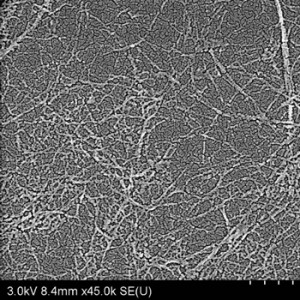
Nanocellulose
Scientists from Edinburgh Napier University and Sappi have developed a low cost way to turn wood into a wonder material that could be used to build greener cars, thicken foods and even treat wounds.
It means Sappi will be able to produce the lightweight material on a commercially viable basis – and without producing large volumes of chemical waste water associated with existing techniques.
The energy-saving process will be used in a new nanocellulose producing pilot plant to be erected by Sappi.
Sappi is a global company focused on providing dissolving wood pulp, paper pulp and paper based solutions.
“Nanocellulose, extracted from wood fibres, has a number of unique optical, barrier and strength properties,” said project coordinator Math Jennekens, R&D director at Sappi Europe.
“Unlike other lightweight, high-strength materials based on fossil fuels it is completely sustainable, making it very desirable as a new material for various industrial and transport applications.”
The versatile material has previously been produced by intensively processing wood pulp to release ultra-small, or ‘nano’ cellulose fibres – each so small that 2000 could fit inside the width of a single strand of human hair.
But the Edinburgh Napier research team said that they have been able to drastically reduce the amount of energy needed to power the process, as well as the need for expensive chemicals.
“What is significant about our process is the use of unique chemistry, which has allowed us to very easily break down the wood pulp fibres into nanocellulose,” said Professor Rob English, who led the research with his Edinburgh Napier colleague, Dr Rhodri Williams.
“There is no expensive chemistry required and, most significantly, the chemicals used can be easily recycled and reused without generating large quantities of waste water.
“It produces a dry powder that can be readily redispersed in water and leaves the nanocellulose unmodified – effectively making its surface a chemical ‘blank canvas’ and so more easily combined with other materials.
“The ability to bring all these attributes together has so far eluded materials scientists working in the field. It is very exciting.”
Nanocellulose produced at the proposed Sappi plant could be used in a wide range of industrial and everyday products and devices because of the way they can improve the properties of materials they are combined with, said Professor English.
“It could be used to thicken water-based products such as paints, foods and concrete,” he said.
“Or when it’s used in plastics to make a composite it can replace glass fibres, which is very attractive in the production of the next generation of lighter, fuel-efficient vehicles.
“Because of its low oxygen permeability it could also be a possible replacement for plastic films in packaging.
“Then there are also applications for it in containing films in lithium batteries and touch screen displays. And as cellulose is inherently bio-compatible and bio-absorbable, there is considerable potential in biomedical applications such as wound dressings and regenerative medicine.”
Group Head Technology, Sappi Limited Andrea Rossi said a pilot production plant was being planned for towards the end of this year.
“Commercial interest in nanocellulose is growing at a phenomenal rate following predictions of a possible 35 million tonnes per year market by the 2020s,” said Professor English.
“And so the key challenge now is very much in business development and understanding the value offered by nanocellulose in our target markets.”







